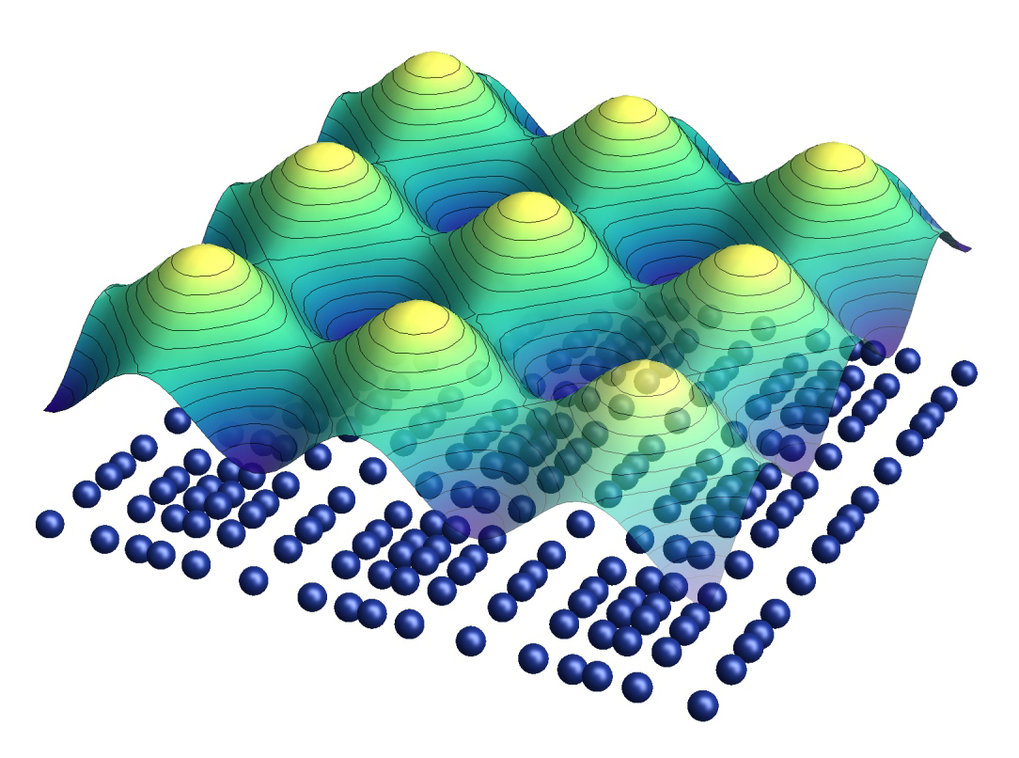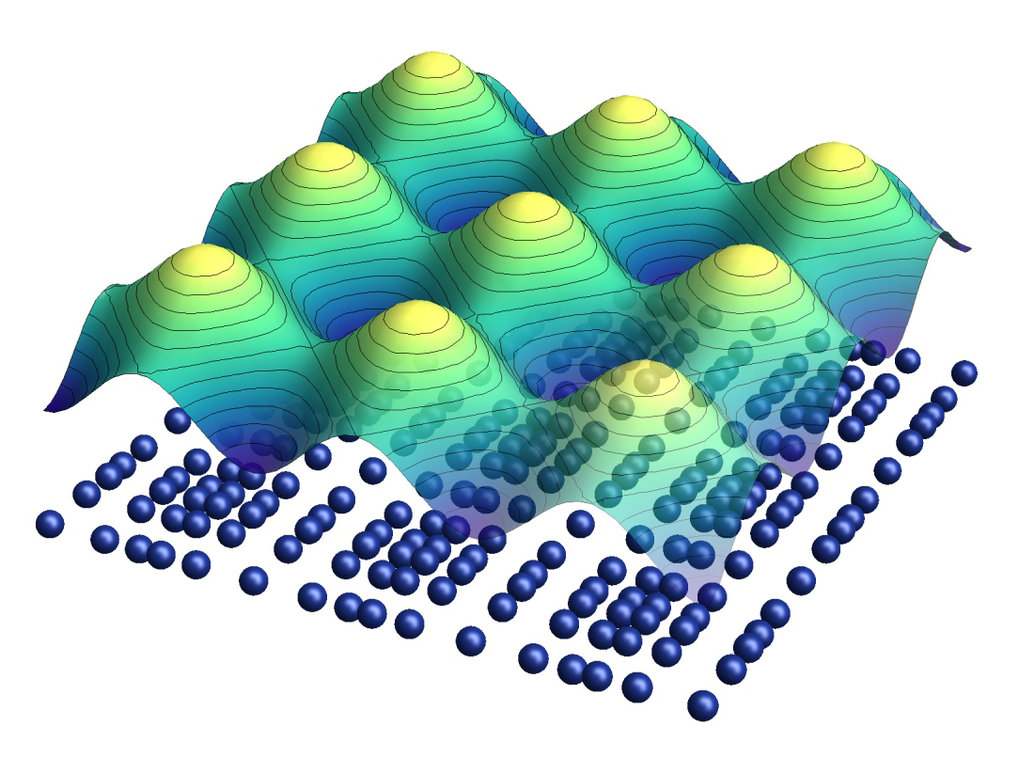Constructive conflict in the superconductor
Charge density waves improve our understanding of the zero-resistance transport of electricity and could explain an unusual interplay of superconducting and magnetic materials
Whether a material conducts electricity without losses is not least a question of the right temperature. In future it may be possible to make a more reliable prediction for high-temperature superconductors. These materials lose their resistance if they are cooled with liquid nitrogen, which is relatively easy to handle. An international team, in which physicists of the Max Planck Institute for Solid State Research in Stuttgart played a crucial role, has now discovered that this form of superconductivity competes with charge density waves, i.e. with a periodically fluctuating distribution of the charges. Since the physicists did not previously take account of this competition in their models, their calculations of the transition temperature, where superconductivity sets in, remained inaccurate. In further work, the researchers at the Stuttgart Max Planck Institute have gained insights into how superconducting materials interact with magnetic ones. They observed that the electronic properties affect crystal vibrations to a greater extent than was to be expected. This effect could help to control material properties such as superconductivity or thermoelectricity.

If electricity from high-power offshore wind farms or even large-scale solar parks in the Sahara is to be distributed to consumers in Germany in future, quite a bit of energy will be lost in the long power lines. Superconducting cables could prevent this if cooling them does not consume more energy than they help to save. Bernhard Keimer and his colleagues at the Max Planck Institute for Solid State Research in Stuttgart want to identify materials that deserve the name high-temperature superconductor both in practical terms and also in terms of our usual perception of temperature. To do this they first have to understand how superconductivity works in these materials and how it can be influenced; these materials are known as high-temperature superconductors, even though they lose their resistance at temperatures which make a Siberian winter seem almost mild. The Stuttgart-based physicists have now taken a further step down this road in two current publications.
According to one of their discoveries we can probably consider ourselves lucky that high-temperature superconductivity - a property which remains promising despite its present disadvantages - exists at all. “It is obviously down to a fortunate coincidence,” says Bernhard Keimer, Director at the Stuttgart Max Planck Institute. This is at least suggested by the observations of the international team that includes not only Bernhard Keimer and his colleagues, but also scientists at the Politecnico di Milano, the European Synchrotron Radiation Facility Grenoble, the University of British Columbia in Canada and further research institutions.
Superconductivity beats the charge density waves in a close competition
The researchers discovered that the superconductivity in one type of copper oxide ceramic competes with a state in which a charge density wave forms. Physicists have known about such charge density waves for decades from two-dimensional materials such as the niobium selenides, for example. Here, the conduction electrons do not distribute uniformly across the crystal like in a metal. On the contrary, they form a regular pattern of regions in which they concentrate to a greater or lesser extent.
“We did not expect the charge density waves in the superconducting cuprates, because they destroy the superconductivity,” says Bernhard Keimer. Instead of concentrating at regular intervals to a greater or lesser extent, the electrons in superconductors join up to form Cooper pairs which can slip through a crystal with zero resistance. Accordingly, the researchers observed the charge patterns only above the transition temperature, the temperature at which the material becomes superconducting.
The regions where charge density waves formed initially expanded as the researchers cooled the material down to the transition temperature, however. As soon as they reached the transition temperature at minus 213 degrees Celsius, the charge density waves suddenly disappeared and superconductivity prevailed. “Superconductivity only just prevailed in this competition,” explains Bernhard Keimer. “If the advantages were distributed slightly differently, there would possibly be no superconductivity at all.”
Charge density waves explain why calculated transitions temperatures were too high
The team of researchers tracked down the charge density waves by scanning yttrium and neodymium barium cuprates of the composition (Y,Nd)Ba2Cu3O6+x with the aid of resonant X-ray diffraction. This provided them with exclusive information on the electrons which found it hard to decide whether they wanted to form a wave or look for a partner so that, together, they could slip more easily through their crystal. The physicists in Bernhard Keimer’s group are now going to perform these measurements on other high-temperature superconductors as well. They want to find out whether all these materials are in electronic competition.
In addition, the researchers want to take account of the conflict between the two electronic states in their theoretical model of superconductivity. “We can already compute the transition temperature of a material quite well with this model, but still end up slightly too high,” says Bernhard Keimer. “The competition with the charge density wave explains this discrepancy so that our predictions should become more accurate in the future.”
Superconductivity can be affected by magnetism
Charge density waves possibly also explain an observation which his team made recently in a different project. A high-temperature superconductor was also instrumental here. It also was composed of yttrium, barium and copper oxide and is described by the formula YBa2Cu3O7, or YBCO for short. The researchers now combined this ceramic with a magnetic material comprising lanthanum, calcium and manganese oxide, which obeys the formula La2/3Ca1/3MnO3 (or LCMO). They stacked up the two substances to form a superlattice, a sandwich of layers only a few nanometres thick, and they had a clear aim in doing this.
“In the meantime we assume that the Cooper pairs in high-temperature superconductors form due to magnetic interactions,” explains Bernhard Keimer. “If this is the case, superconductivity should be affected by magnetism in order to increase the transition temperature.” The special form of magnetism in the LCMO may not be suitable for this, however, because this material is ferromagnetic, i.e. the magnetic moments of the individual atoms all align in one direction, as in iron. And this form of magnetism breaks up the Cooper pairs, thus harming the superconductivity, and decreases the transition temperature. This material is good for investigating how the transition temperature reacts to the magnetism, however, and for the detailed basis for its effect.
And indeed the researchers observed what they had expected: in a sandwich with LCMO, the transition temperature of the YBCO decreased, and the decrease was greater the thinner the researchers made the YBCO layers in comparison to the LCMO. Bernhard Keimer and his colleagues now wanted to find out more details of the interactions between the different layers. They specifically wanted to determine how the electronic processes in a layer - the superconductivity on the one hand, and the magnetism on the other - affect the vibrations of the atoms in this layer. Physicists call the interaction electron-phonon coupling, where phonon stands for vibration.
The coupling between electrons and vibrations affects material properties
An illustrative description of the mechanism is that the electrons act like springs between the atoms. The state the electrons adopt affects the springiness of the springs and thus their ability to couple vibrations. The electron-phonon coupling is the basis of a few useful material properties. They include the ability of some materials to convert a temperature difference into a voltage, and also conventional superconductivity, where it is the vibrations of the crystal lattice and not the magnetism that bonds the Cooper pairs together. The researchers have investigated the electron-phonon coupling by observing selected vibrations with a Raman spectrometer as they cooled the material sandwich until magnetic order appeared in the LCMO and superconductivity in the YBCO.
According to the measurements made by the researchers in Stuttgart, one vibration of the copper oxide group in the YBCO layer changed its frequency when the superconductivity set in at the transition temperature. One vibration of the manganese oxide group in the LCMO layer reacted in the same way when the ferromagnetic order formed in the material. “This didn’t really surprise us,” said Bernhard Keimer. “But we didn’t expect that the superconductivity would also affect the vibration of the manganese oxide.”
The electron-phonon coupling therefore also makes itself felt across material boundaries, and this occurs not only right on the boundary between the two substances, but in the whole LCMO layer. This is unexpected, because the vibrations deep in the two layers at least are usually as independent as two children playing on adjacent swings. The Stuttgart-based researchers cannot yet completely explain their observations, but they already have some ideas and meanwhile also indications of what could cause the long-range electron-phonon coupling.
Charge density waves explain the long-range electron-phonon coupling
One condition for the cross-boundary coupling is that, right on the boundary, the copper and manganese atoms are bound very strongly to each other via an oxygen atom in each case. This bond acts like a rubber band between two swings. Moreover, the copper and manganese atoms can oscillate with the same frequency so that a vibration of the copper atoms can easily drag along the manganese atoms. Just as two children can only swing with the same rhythm if their swings have the same length, i.e. they swing with the same frequency. And assuming that their two swings are connected to each other with a strong rubber band: one child can only pull the other along if both are sitting on swings of the same length.
After all, one child in such a swing tandem requires powerful pushers in order for the other one to swing along. In the same way, the YBCO-LCMO superlattice requires a strong trigger in order for the manganese atoms to react to the vibration of the copper atoms. If this trigger comes from the electrons, more precisely from the nascent superconductivity, the electron-phonon coupling must be strong. The YBCO-LCMO sandwich fulfils this condition as well. “The fact that the effect remains noticeable in the whole LCMO layer as well is possibly again caused by the charge density waves in the YBCO,” explains Bernhard Keimer. “In our current experiments we have also already found indications that the sandwich structure stabilises this competing order.”
The long-range electron-phonon coupling in the LCMO-YBCO superlattice is not helpful in driving up the temperature at which the high-temperature superconductor loses its resistance. “But it gives us the opportunity to influence other properties such as thermoelectricity or conventional superconductivity,” explains Bernhard Keimer. And it increases the understanding of how magnetic and superconducting materials influence each other. This in turn brings the researchers in Stuttgart further towards their ultimate goal: to develop superconductors that can transport electricity in an energy efficient way from wind farms and solar parks to the consumer.
PH
